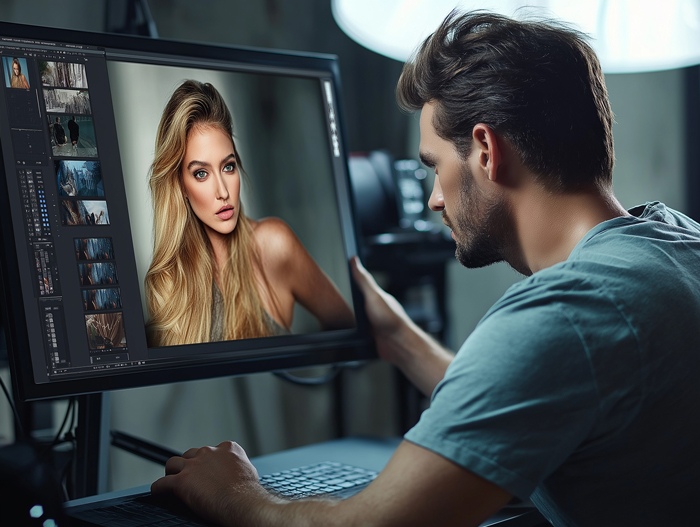In the world of photography, taking a perfect shot is just the beginning of the creative process. Editing plays an essential role in turning a good photograph into a stunning masterpiece. Whether you’re a professional photographer or a hobbyist, having the right editing tools can significantly improve your workflow and results. With an array of apps and software available, it can be overwhelming to choose the right one for your needs. This article explores the best editing apps and software for photographers, whether you’re working on your smartphone or a desktop, to help you edit like a pro.
1. Adobe Lightroom (Desktop & Mobile)
Adobe Lightroom is one of the most popular photo editing tools for photographers, and for good reason. It offers a comprehensive suite of features, including powerful tools for color correction, exposure adjustment, noise reduction, and sharpening. Lightroom is ideal for both beginners and advanced users, with an intuitive interface that lets you focus on your creative process without being bogged down by complicated settings.
One of the standout features of Lightroom is its non-destructive editing. This means you can make changes to your photos without altering the original image file, allowing for unlimited experimentation and fine-tuning. The mobile version of Lightroom syncs with the desktop app, enabling seamless editing across multiple devices.
For photographers looking to organize their work, Lightroom also offers robust cataloging features. You can rate, tag, and filter images to keep your library organized. Adobe’s cloud storage ensures that your images and edits are always accessible, whether you’re in the studio or on the go.
2. Adobe Photoshop (Desktop)
While Lightroom handles basic adjustments, Adobe Photoshop is the go-to software for more advanced edits. Photoshop is synonymous with professional photo manipulation, offering an extensive range of tools for creating and transforming images. Whether you’re removing blemishes, compositing multiple photos, or creating elaborate digital art, Photoshop’s versatility makes it a must-have for many photographers.
With tools like layers, masks, and advanced retouching capabilities, Photoshop allows for precise, detailed work. The software supports a wide variety of file formats, including RAW files, and its integration with other Adobe products, such as Illustrator and After Effects, makes it an essential tool for those involved in multimedia projects.
Despite its steep learning curve, Photoshop remains the standard for photo manipulation and is the preferred choice for photographers looking to take their editing skills to the next level.
3. Capture One (Desktop)
Capture One by Phase One is a premium photo editing software that’s gaining a strong following among professional photographers, particularly those working with medium format cameras. Capture One is known for its excellent color grading and tethering capabilities, making it a great choice for studio photographers.
The software excels at handling large RAW files and offers detailed editing tools, including layer-based adjustments, advanced masking tools, and excellent noise reduction. Capture One’s unique color grading tools allow for precise control over color tones, making it an excellent choice for photographers who want to take their images to the next level in terms of color accuracy.
One of the key features of Capture One is its powerful tethering capabilities. Photographers who shoot portraits or product photography in a studio will appreciate the ability to connect their camera directly to the software and preview images in real-time on a larger screen.
4. Affinity Photo (Desktop & iPad)
Affinity Photo is a popular alternative to Adobe Photoshop, especially for those who prefer a one-time purchase over a subscription model. It offers many of the same features as Photoshop, including advanced tools for retouching, compositing, and image manipulation.
Affinity Photo is compatible with both desktop and iPad, making it a versatile tool for photographers who want to edit on the go. Its powerful selection tools, support for layers and masks, and seamless integration with RAW files make it an excellent choice for photographers who need professional-grade software without the ongoing costs associated with Adobe products.
One of the standout features of Affinity Photo is its performance. The software runs smoothly even on lower-spec machines, making it a great option for photographers with more modest setups.

5. Snapseed (Mobile)
For photographers who need a quick and effective solution for editing photos on their smartphones, Snapseed is one of the best mobile apps available. Developed by Google, Snapseed is free and offers a range of tools that can transform your photos with ease.
Snapseed includes an array of filters, as well as essential editing tools such as cropping, straightening, brightness adjustment, and color correction. It also features advanced options like the ability to remove objects from your image and the “Selective” tool, which lets you adjust specific areas of a photo without affecting the entire image.
The user interface is intuitive, and the app allows for non-destructive editing, meaning you can revert back to your original image at any time. Snapseed is perfect for photographers who want a quick and easy solution for editing their images on the go.
6. VSCO (Mobile)
VSCO is another excellent mobile app for photographers who want to enhance their photos without spending too much time on editing. It’s known for its minimalist design and easy-to-use interface, making it a popular choice for those who want to quickly adjust their images.
VSCO offers a range of filters that emulate classic film styles, making it an ideal app for photographers who enjoy creating a nostalgic or vintage look. The app also includes standard editing tools like exposure adjustment, contrast, saturation, and sharpness, as well as advanced options such as grain and fade effects for a more artistic touch.
While the free version offers a solid set of tools, the premium subscription unlocks a wider variety of filters and additional features, giving photographers more creative flexibility.
7. Darktable (Desktop)
Darktable is an open-source alternative to Lightroom, offering powerful editing tools and a sleek interface. It’s especially popular among photographers who prefer a non-subscription model and want a free solution with similar capabilities to Lightroom.
Darktable supports RAW files and offers a comprehensive set of editing tools, including exposure correction, white balance adjustments, color grading, and lens correction. It also has advanced features like tethering, geotagging, and tagging, which are particularly useful for managing large photo libraries.
While the interface may take some getting used to, Darktable’s robust features and flexibility make it a great option for photographers on a budget.
8. Luminar AI (Desktop & Mobile)
Luminar AI by Skylum is an AI-powered photo editing software designed to streamline the editing process. The software uses artificial intelligence to analyze your photos and suggest adjustments, making it an excellent choice for photographers who want to enhance their images quickly and easily.
Luminar AI offers a wide range of editing tools, including sky replacement, portrait enhancement, and structure editing. Its user-friendly interface allows for a more intuitive editing experience, and the AI-driven features can save time on tasks that would normally require manual adjustments.
Whether you’re working with landscape or portrait photography, Luminar AI makes it easy to achieve stunning results with minimal effort.
Conclusion
The world of photo editing is vast, with a multitude of apps and software tools available to photographers of all skill levels. Whether you’re editing on a desktop or a mobile device, there is a solution that can help you take your photos to the next level. From the powerful features of Adobe Lightroom and Photoshop to the intuitive interface of Snapseed and VSCO, these apps and software cater to different needs and preferences.
Choosing the right tool ultimately depends on your specific requirements, budget, and the level of control you want over your edits. With the options listed above, photographers can unlock new creative possibilities and enhance their images with professional-quality results.
Editing Like a Pro: Best Apps and Software for Photographers
806
previous post



